2. 宁波大学地理与空间信息技术系, 宁波 315211
2. Department of Geography & Spatial Information Techniques, Ningbo University, Ningbo 315211, China
近年来, 随着生态文明建设的深入, 水环境作为生态环境的重要组成部分受到高度重视[1~3].我国政府针对严峻的水环境形势颁布了一系列政策, 其中最重要的为“水十条”[4]和“河长制”[5]的实施.在这一背景下, 近年来各地开展了大量的水环境修复与提升工作[6].然而, 我国的水污染问题较为复杂, 且由于社会发展水平等因素存在较大的区域差异, 治水策略需建立在对区域污染特征的准确分析之上, 才能保证治水工作的效果.目前, 我国的水环境评价主要基于常规水质参数之上, 如化学需氧量[7]、氨氮[8]、总氮[9]和总磷[10]等.这些指标的贡献污染物来源复杂, 包括多种点源和面源污染物[11, 12], 在目前的治水任务下, 由于常规水质指标缺乏对区域污染特征的准确指示, 治水工作缺乏精确指引.
溶解性有机物(dissolved organic matter, DOM)是各类污染源中的有机物所组成, 这其中包含有各类排放源的信息, 可作为污染物溯源分析的着手点. DOM的结构和性质可通过光谱技术进行快速分析, 通常使用溶解性有机碳(dissolved organic carbon, DOC)和在254 nm下的紫外吸光度(UV254)作为指示参数, 但是对这些方法在DOM的组成方面提供的信息有限[13, 14].三维荧光激发-发射矩阵结合平行因子分析(EEM-PARAFAC)是一种针对水中溶解性有机物的分析技术, 其基本原理是水中不同类别有机物对应于独立的特征荧光组分, 该方法可以对EEM中丰富的有机物化学信息进行半定量分析[15].近几年来随着平行因子分析算法的快速进步, 其在水体污染物溯源方面表现出了巨大的应用前景[3, 16~19]. EEM-PARAFAC技术的广泛应用开始于2008年[15, 20, 21], 其在欧美国家最早是被用于研究海水中DOM的迁移转化, 对于地表水及废水的应用研究集中于最近五年.随着研究的深入, EEM-PARAFAC技术在不同地表水水环境中均表现出明显优势, 被认为是“可以为地表水中DOM研究开启一扇新窗”的工作[22].以宁波市为例, 其地表水主要污染物来源为农业面源、生活污水, 路面径流以及分散的畜禽养殖等.用EEM-PARAFAC识别的特征组分, 如类腐殖酸物质(humic-like substances)、类色氨酸物质(tryptophan-like substances)和类酪氨酸物质(tyrosine-like substabces)等, 可对宁波地表水中主要污染源, 如农业面源、路面径流以及生活污水等进行高灵敏响应, 其反馈的信息可有效弥补常规指标在污染物来源指示方面的不足[23].
按照宁波市目前的城市化发展程度, 可大致分为城市区域, 城乡结合区域以及农村区域三类, 由于区域经济发展和城市建设的差异性, 水环境污染程度以及污染来源存在较大差异[16].本文选取了宁波市4个典型汇水区, 分别代表三类不同城市化程度, 根据DOM光谱特性确定区域水环境污染来源.本文的目的是:①探讨城市化程度与水体污染之间的关系; ②检验EEM-PARAFAC技术是否能够有效指示不同发展结构下区域水质的差异及源污染, 旨在为不同发展程度的区域水质恢复与治水策略制定提供理论支撑.
1 材料与方法 1.1 研究区域本研究选取宁波市的4个汇水区:海曙(A1)、浦口闸(A2)、芦江河(A3)以及四明湖(A4)作为研究对象, 地理位置如图 1所示. A1是城市区域, 第三产业发达, 占经济总量的80%以上, 区域内管网建设完善, 以商业中心和住宅区为主, 不透水路面覆盖率达到80%以上. A2属于城乡结合区域, 经济主体为第二产业, 市政管网建设在乡村区域不完善, 城市区域市政基础设施相对陈旧. A3和A4为农村区域, 存在大片林地和园地(>70%), 花木种植及农田耕作为主要产业, 存在污水直排区域.以上4个区域的基本土地利用数据列于表 1.

|
图 1 宁波市四个研究区域的土地利用类型 Fig. 1 Land-use maps of the four studied watersheds in Ningbo |
|
|
表 1 本研究中4个区域的基本信息 Table 1 Basic information of the four watersheds in this study |
1.2 样品采集与分析 1.2.1 样品采集
共采集594个地表水样品, 分别来自于4个研究区域内的主要河流, 根据采样原则合理分布采样点, 采样日期为2016年4月至2016年9月.其中区域A2采样时间为春季, 其余区域采样时间为夏季.在样品采集前后无降雨发生, 排除降雨对于结果的影响.样品采集后快速运回实验室, 在常温下经过0.45 μm的聚醚砜膜过滤, 滤液倒入经过酸清洗的玻璃容器中, 放入4℃的冰箱内储存, 在一个星期内完成相关指标的测试.
1.2.2 DOC和紫外吸收光谱的测定使用DOC-VCPH分析仪器(Shimadzu Corporation, Tokyo, Japan)在高温催化氧化状态下测定样品中DOC的浓度.使用Milli-Q超纯水作为空白, 采用紫外可见分光光度计(日立U-3900), 扫描范围为200~700 nm, 以0.5 nm波长为间隔, 测量UV-Vis吸光度.通过采用254 nm处样品紫外吸光度除以DOC浓度得到比紫外吸光度(SUVA254)[24, 25]. SUVA254可作为评价溶解性有机碳含量芳香性的参数. SR值为275~295 nm间光谱斜率和在350~400 nm间光谱斜率的比值, SR与DOM的平均分子量呈反比[26].
1.2.3 三维荧光光谱测试与PARAFAC分析水样温度和室温一致后进行三维荧光光谱测试.使用装有150W氙灯的日立F-4600荧光光谱仪(Hitachi, Tokyo, Japan)测定EEM. EEM光谱的激发波长(Ex)220~450 nm, 扫描间隔5 nm; 发射波长(Em)260~600 nm, 扫描间隔1 nm. EEM信号在S/R模式下采集, 激发与发射波长的狭缝宽度均为5 nm.使用Milli-Q超纯水作为空白.所有数据均按照每天使用超纯水的拉曼散射峰Ex/Em=275/303 nm的强度进行归一化.用Fmax(单位R. U.)值评估通过EEM-PARAFAC分析确定的荧光成分的强度.关于EEM-PARAFCA分析的详细参数条件可见文献[23].
通过荧光光谱还可以得到其他荧光参数的信息.荧光指数(FI, 在激发波长370 nm时发射波长450 nm和500 nm的比值)用于区分DOM的来源[22].腐殖化指数(HIX)表示有机物腐殖化程度, 计算方法是将435~480 nm区域的发射强度除以300~345 nm区域的发射强度[27].自生源指标(BIX)用于指示DOM的自生源贡献比例, 计算方法为Ex=310 nm时, Em在380 nm与430 nm处的荧光强度比值[28, 29].
1.3 统计分析主成分分析法(PCA)是一种多变量统计方法, 通过降维分析得到的新变量能较大程度反映原始变量的有效信息, 在荧光光谱分析中有很好的特征提取性能[30].使用Origin (版本8.6, Origin Lab., USA)进行主成分分析及相关图表的绘制.本文使用SPSS(版本18, IBM, USA)对不同区域样本的水质指标进行正态性检验, 使用单因素方差分析(ANOVA)确定各区域水质参数之间的差异性.所有的分析都设定α水平0.05为确定显著性.使用ArcGIS(10.2版, ESRI, USA)结合统计年鉴确定每个区域的经济因素和土地利用类型.
2 结果与讨论 2.1 不同区域水质参数特征 2.1.1 DOC分布特征根据单因素方差分析, 各区域的DOC浓度存在显著性差异(P<0.001, ANOVA).区域A2的DOC浓度最高, 达到7.45 mg·L-1; 其次是区域A1, DOC浓度为3.18 mg·L-1 [图 2(a)].在区域A3和A4, DOC浓度分别为2.16 mg·L-1和2.62 mg·L-1.结果表明农村区域中DOC远小于城市和城乡区域.区域A2水体中有机物浓度最高, 是由于区域内基础建设的老旧导致城市中污废水处理不当以及工业废水的排放等[31].然而, 仅有DOC浓度的数据不足以表明城市化发展对于水质的影响, 以下将进一步通过DOM特征参数进行探讨.
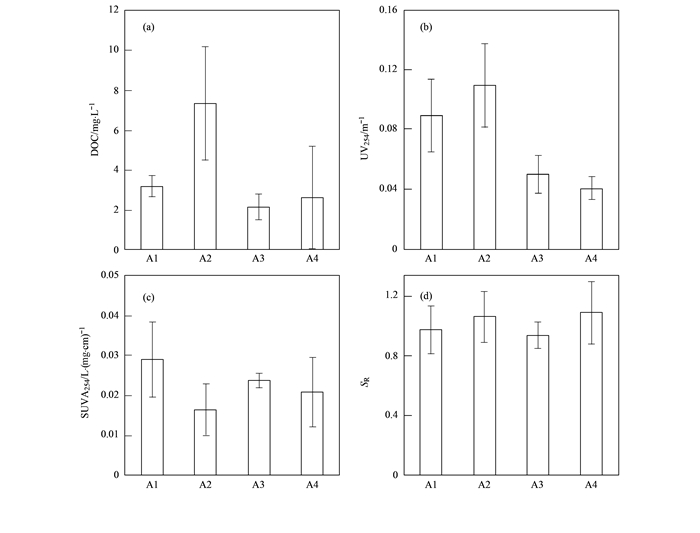
|
图 2 不同区域中DOC、UV254、SUVA254和SR值 Fig. 2 Values of DOC, UV254, SUVA254, and SR of the four studied watersheds |
通过紫外分光光度法进一步分析DOM的化学特性[26]. UV254反映的是水中天然存在的腐殖质类大分子有机物以及含C=C双键芳香族化合物等[32, 33].如图 2所示, UV254和DOC的浓度呈现出相似的趋势.区域A2的UV254值最高, 区域A1的UV254值略低于区域A2, 区域A3和A4的UV254值都较低.此外, SUVA254值在不同区域中也存在显著性差异(P<0.001, ANOVA), 区域A1的SUVA254值最高, 区域A2的值最低.这说明A1相比其他区域水体内单位溶解性有机碳芳香化程度更高.区域A2的SUVA254值低可归因于水体DOM污染主要来源于生活和工业排放的废水, 而非由雨水径流冲刷土壤所形成.这一结果符合文献[34]中提到的生活污水等的SUVA254相比天然有机物质更低. 4个区域的SR和DOC浓度呈现出一致的变化趋势, 与SUVA254值存在相反的变化趋势, 表明DOM分子量越大, 芳香性越强, 腐殖化程度越高.对4个区域的紫外光谱分析可大致看出不同城市化发展程度下区域内的DOM存在差异, 在土地利用和覆盖植被方面存在差异的农村区域A3和A4的紫外光谱特征也存在一定差异, 但是由于差异较小以及水体中DOM的组成复杂, 紫外光谱分析不足以解释水体中DOM组成的差异, 下面将采用EEM-PARAFAC技术对DOM的组成进行进一步分析.
2.2 DOM的荧光光谱分析 2.2.1 DOM荧光特征运用EEM-PARAFAC分析法对4个区域的591个样品进行了分析, 共得到7个荧光组分, 如图 3所示.
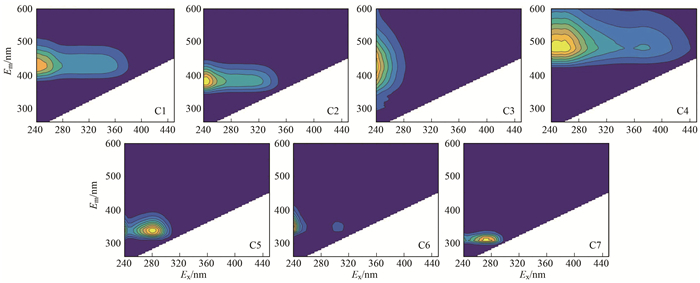
|
图 3 基于EEM-PARAFAC分析得到的荧光特征组分 Fig. 3 Seven components identified by the EEM-PARAFAC analysis |
单因素方差分析(ANOVA)结果[图 4(a)]表明C1、C2、C4在区域A1、A2和区域A3、A4存在显著性差异(P<0.001, ANOVA).根据已有研究可知, C1和C4主要为来源于陆源有机质[35, 36], C2普遍存在于地表径流和废水中[20, 37], 主要为与人类排放相关的类腐殖质物质.城市化较高的A1和A2区域中类腐殖质物质(C1、C2和C4)高于农村区域A3和A4, 表明不透水路面增加引起的地表径流对于水质产生了明显影响.根据Ex/Em波长可知C3为C1的降解产物, 其腐殖化程度小于其他类腐殖质, 在区域A1和其他3个区域之间存在显著性差异(P<0.001, ANOVA).由于区域A1内水体流动性较差, 河流底部污泥淤积, 且采样时间为夏季, 微生物活性强, 藻类丰富, 光照强度大, 使得来自内源的C3增多, 所以内河中的底泥也是主要污染源之一.有研究表明C5为类酪氨酸物质, 主要来源于生活污水, 代表的是分解程度小, 较新鲜的类蛋白质[38]; 而C7为经过降解, 已经存留一段时间的类蛋白质[39, 40].各区域C5明显大于C7 [图 4(a)], 表明新鲜生活污水的排入是主要的污染源之一. C5和C7在4个区域存在显著性差异(P<0.001, ANOVA), 区域A1、A2水体中类蛋白质类物质浓度高于区域A3、A4. C6为色氨酸物质, 可能与含药物及个人护理用品(PPCPs)的生活污水排放有关[41].区域A1和A2之间无显著差异(P>0.05, ANOVA), 但区域A3和区域A4的C6组分存在显著差异(P=0.008, ANOVA), 表明以农耕为主的农村区域比以林地为主的农村区域的水体中新兴有机污染物等的浓度更高.
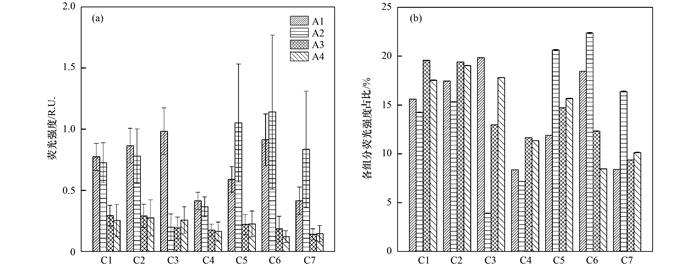
|
图 4 各区域荧光组分的荧光强度及荧光组分占比 Fig. 4 Fluorescence intensity and percentage of each fluorescent component in the different watersheds |
DOM的差异符合之前的研究, 在城市区域A1水体中的DOM以类腐殖质有机物(C1~C4)为主(61.3%)[图 4(b)], 而区域A2水体以类蛋白质组分(C5~C7)浓度(59.4%)为主.在城乡结合区域, 第二产业快速发展, 伴随人口急剧增加, 水体的污染以生活污水以及工业废水排放等为主[18, 42].这个过程中污水收集设施往往落后于城市扩张, 因此导致生活污水等对地表水影响显著.在城市区域, 市政基础设施建设相对完善且污染管控较好, 生活污水等污染被有效控制[42], 污染物主要来源于雨水对于不透水路面的冲刷所带来的地表径流污染, 同时冲刷到水体中的泥土沉积物等累积在城市内河底部也可释放大量的污染物[43].区域A3、A4的DOM浓度低, 但是类腐殖质物质占比明显大于类蛋白质物质的占比(A3:63.6%和36.4%, A4:65.7%和34.3%), 表明以农林为主的农村区域污染主要来源于雨水对于土壤的冲刷, 即以面源污染为主[44, 45].在两个农村区域, C3和C6的差异也反映出林地与农田的差别.在林地区域, 面源带来的污染物更高(C3=17.8%, C6=8.5%); 而农业为主的区域, 水体中类蛋白质物质的比例(C3=13.0%, C6=12.3%)有增加趋势.
2.2.2 DOM来源分析荧光参数对于水体中溶解性有机物的来源也有一定的指示作用, 图 5为各区域的荧光参数分布.由BIX-HIX图[图 5(b)]可看出, 4个区域中的DOM来源既有陆源也有内源, 区域A1和A2的BIX值大于A3和A4, 表明区域A1和A2中的DOM偏向于内源[46], 而区域A4中DOM相比区域A3更偏向于陆源.区域A4更倾向陆源来源表明在林业为主的区域, 林地对雨水径流的拦截有助于区域水质的提升. HIX-FI分布图也验证了这一点, 区域A1的FI值显示其中的DOM多来源于内源, 结合荧光组分的分析结果可推知底泥中DOM经过降解释放出污染物.区域A2中DOM的腐殖化程度明显低于其余3个区域, 与区域A2中类蛋白质物质占比较高的结果相一致.
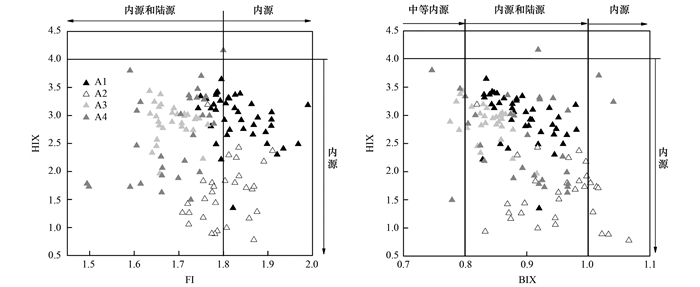
|
图 5 各区域荧光指数分布 Fig. 5 Distribution of the fluorescence indexes in the different watersheds |
4个区域所有采样点的荧光组分的主成分分析如图 6所示.在荧光组分强度和比例的分析中, 主成分1和主成分2的累积贡献率分别达到了92.18%和76.54%, 表明图中的采样点的聚集和趋势可以通过区域中DOM的特征解释.在荧光组分强度分析中[图 6(a)], 主成分1的方向和污染特征基本一致.在城市和农村区域, DOM以类腐殖质为主; 而城乡结合区域A2的DOM以类蛋白质为主, 这和前面的结论是一致的.区域A3和A4的点位大致聚集在一起, 表明DOM来源类似, 但区域A3的采样点相比区域A4更接近类腐殖质(C1、C2和C4)方向, 表明尽管这两个农村区域在不透水路面覆盖率和人口密度差异较小, 但是荧光组分可以较敏感地表现出水体污染特征的差异.此外, 区域A2中部分采样点与区域A3和A4重叠, 表明区域A2中也存在污染程度较低的河流, 这与实际情况相一致.

|
图 6 4个研究区域内荧光组分和荧光组分所占比例的主成分分析 Fig. 6 Principal component analysis of the fluorescent components and the percentage of each fluorescent component in the four studied watersheds |
在荧光组分比例方面, 从图 6(b)可以看出PC1代表陆源性DOM, 而PC2则与变量C5和C7相关.区域A3和A4中绝大部分的点位与C1、C2和C4的方向一致, 表明在农村区域水体中的DOM主要为来源于陆源如农田、森林等的大分子类腐殖质, 再次表明农业面源是主要污染源之一[45]. A1的采样点集中在C3和C6中间, 说明底泥降解产物等物质在A1中具有较高比例, 由此表明城市区域水体中底泥污染的问题对城市水体治理较为重要.在圆圈A内, A2的采样点主要位于其人口密集区域, 此部分采样点和C5及C7相关性很强, 是由于城乡结合区域污废水收集处理设施不完善所致[47]; 圆圈B内的采样点主要为第二产业主导区域, 表明在这些采样点周围可能存在工业废水等输入, C6可能对该类废水具有一定指示作用; 圆圈C内A2的采样点和A3、A4的采样点相聚集, 表明部分A2区域内河流也具有农村区域河流的DOM特征.
2.3.2 经济指标和各项水质参数回归分析由上述的主成分分析可以看出, 在不同城市化程度的背景下, 4个区域水体的污染各有特点.研究表明城市化背景下社会经济的发展对于水质具有重要影响[2].对4个区域的经济因素进行Pearson相关性分析, 经济因素之间存在很强的相关性(表 2).所以本研究的第二个假设, 即EEM-PARAFAC分析是否可以反映不同发展结构下水质的差异, 将通过经济指标(人均GDP)与各荧光特征组分进行检验.
|
|
表 2 经济因素之间的Pearson相关性1) Table 2 Pearson correlation analysis between different economic factors |
人均GDP和类腐殖质组分相关性较强(r2>0.8), 这表明经济发展改变对于水质存在影响.经济发展增加了城市化率, 使土壤截留作用减弱, 更多疏水性芳香性强的大分子有机物质未经充分的土壤吸收, 直接进入水体中. 图 7中C1、C2、C4组分和人均GDP均呈现较好的正相关, 这和之前研究表明经济发展和城市化对水生态系统呈负作用的结论一致[2, 48].相比之下, 人均GDP与类蛋白质类物质的相关性相对较弱(r2<0.8), 这其中A2区域的相对离群是导致相关性差的主要原因, 若排除A2则其他3个区域的相关性也是较高的.这一结果表明A2区域的污水收集处理能力与经济发展程度上存在滞后现象, 这与城乡区域的基础设施现状相一致, 以上结果表明, 与设施完善的城区相比, 其在污水收集和处理方面还有大量工作需要完善. EEM-PARAFAC的分析结果表明该技术通过对DOM的解析, 可以准确表达流域水污染特征并揭示水质提升的关键策略.
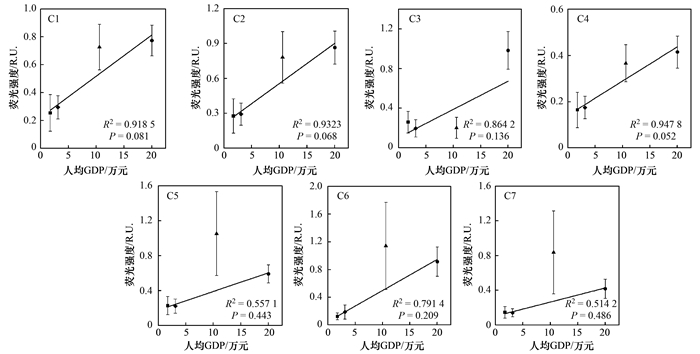
|
图 7 各区域荧光组分C1~C7和人均GDP的线性回归分析 Fig. 7 Pearson correlation analysis between different economic factors |
(1) 地表水中溶解性有机物与土地利用表现出密切的相关性, 以城市化、经济发展和农业生产为代表的人类活动在总量和组成两方面对流域水体中溶解性有机物造成显著影响, 流域水污染呈现出明显差别.
(2) 基于EEM-PARAFAC分析, 给出了不同土地利用类型条件下人类活动对于地表水的影响:在宁波市中心城市区域, 由于污水收集处理设施相对完善, 水体中污染物主要来源于硬化地面所导致的径流污染; 在城乡结合区域, 水体中的污染物则更多地来源于未能有效收集处理的生活污水以及工业废水; 而在农村区域, 水体中的污染物更多来源于农田和林地的面源污染; 对于具有混合的土地利用区域, 以上三类污染同时存在.
(3) 按照城市化进程和经济发展来看, 不同阶段水体中污染物呈现出不同特征, 由EEM-PARAFAC分析所提供的污染源组成和含量数据可更加准确地揭示复杂污染条件下的污染物来源, 这为不同区域的水环境提升和保持提供了更加精确的污染物信息数据, 在下一步更加深入的治水工作中具有一定意义.
| [1] | Liu D, Liu C L, Fu Q, et al. Projection pursuit evaluation model of regional surface water environment based on improved chicken swarm optimization algorithm[J]. Water Resources Management, 2018, 32(4): 1325-1342. DOI:10.1007/s11269-017-1872-6 |
| [2] | Cheng X, Chen L D, Sun R H, et al. Land use changes and socio-economic development strongly deteriorate river ecosystem health in one of the largest basins in China[J]. Science of the Total Environment, 2018, 616-617: 376-385. DOI:10.1016/j.scitotenv.2017.10.316 |
| [3] | Meng F G, Huang G C, Yang X, et al. Identifying the sources and fate of anthropogenically impacted dissolved organic matter (DOM) in urbanized rivers[J]. Water Research, 2013, 47(14): 5027-5039. DOI:10.1016/j.watres.2013.05.043 |
| [4] |
石效卷, 李璐, 张涛. 水十条水实条——对《水污染防治行动计划》的解读[J]. 环境保护科学, 2015, 41(3): 1-3. Shi X J, Li L, Zhang T. Water pollution control action plan, a realistic and pragmatic plan——an interpretation of water pollution control action plan[J]. Environmental Protection Science, 2015, 41(3): 1-3. DOI:10.3969/j.issn.1004-6216.2015.03.001 |
| [5] |
姜斌. 对河长制管理制度问题的思考[J]. 中国水利, 2016(21): 6-7. Jiang B. Considerations for leader responsible system in governance of rivers and lakes[J]. China Water Resources, 2016(21): 6-7. DOI:10.3969/j.issn.1000-1123.2016.21.004 |
| [6] |
刘国锋, 包先明, 吴婷婷, 等. 水葫芦生态工程措施对太湖竺山湖水环境修复效果的研究[J]. 农业环境科学学报, 2015, 34(2): 352-360. Liu G F, Bao X M, Wu T T, et al. Purification of water in Zhushan bay of Taihu Lake with water hyacinth ecological engineering[J]. Journal of Agro-Environment Science, 2015, 34(2): 352-360. |
| [7] | Lee J, Lee S, Yu S, et al. Relationships between water quality parameters in rivers and lakes:BOD5, COD, NBOPs, and TOC[J]. Environmental Monitoring and Assessment, 2016, 188(4): 252. DOI:10.1007/s10661-016-5251-1 |
| [8] |
杜慧玲, 于晓英, 曲茉莉. 松花江干流哈尔滨段COD和氨氮动态水环境容量研究[J]. 水资源与水工程学报, 2018, 29(2): 69-75, 83. Du H L, Yu X Y, Qu M L. Research on COD and NH3-N dynamic environmental capacity in Harbin section of the Songhua River[J]. Journal of Water Resources and Water Engineering, 2018, 29(2): 69-75, 83. |
| [9] |
庆旭瑶, 任玉芬, 吕志强, 等. 重庆市主城区次级河流总氮总磷污染特征分析及富营养化评价[J]. 环境科学, 2015, 36(7): 2446-2452. Qing X Y, Ren Y F, Lü Z Q, et al. Characteristics of total nitrogen and total phosphorus pollution and eutrophication assessment of secondary river in urban Chongqing[J]. Environmental Science, 2015, 36(7): 2446-2452. |
| [10] | Wang S R, Jin X C, Yan P, et al. Phosphorus fractions and phosphate sorption characteristics in relation to the sediment compositions of shallow lakes in the middle and lower reaches of Yangtze River region, China[J]. Journal of Colloid and Interface Science, 2005, 289(2): 339-346. DOI:10.1016/j.jcis.2005.03.081 |
| [11] | Cheng X, Chen L D, Sun R H, et al. An improved export coefficient model to estimate non-point source phosphorus pollution risks under complex precipitation and terrain conditions[J]. Environmental Science and Pollution Research, 2018, 25(21): 20946-20955. DOI:10.1007/s11356-018-2191-z |
| [12] |
李昂, 李晔, 成唯, 等. 汤逊湖流域农业面源氮、磷入湖通量计算[J]. 环境科学与技术, 2016, 39(10): 113-117. Li A, Li Y, Cheng W, et al. Calculation of agricultural non-point source of nitrogen and phosphorus loading from Tangxun lake watershed into the lake[J]. Environmental Science & Technology, 2016, 39(10): 113-117. |
| [13] | Guo W D, Xu J, Wang J P, et al. Characterization of dissolved organic matter in urban sewage using excitation emission matrix fluorescence spectroscopy and parallel factor analysis[J]. Journal of Environmental Sciences, 2010, 22(11): 1728-1734. DOI:10.1016/S1001-0742(09)60312-0 |
| [14] | Vera M, Cruz S, Boleda M R, et al. Fluorescence spectroscopy and parallel factor analysis as a dissolved organic monitoring tool to assess treatment performance in drinking water trains[J]. Science of the Total Environment, 2017, 584-585: 1212-1220. DOI:10.1016/j.scitotenv.2017.01.184 |
| [15] | Stedmon C A, Bro R. Characterizing dissolved organic matter fluorescence with parallel factor analysis:a tutorial[J]. Limnology and Oceanography Methods, 2008, 6(11): 572-579. DOI:10.4319/lom.2008.6.572 |
| [16] | Hosen J D, McDonough O T, Febria C M, et al. Dissolved organic matter quality and bioavailability changes across an urbanization gradient in headwater streams[J]. Environmental Science & Technology, 2014, 48(14): 7817-7824. |
| [17] | Nimptsch J, Woelfl S, Osorio S, et al. Tracing dissolved organic matter (DOM) from land-based aquaculture systems in North Patagonian streams[J]. Science of the Total Environment, 2015, 537: 129-138. DOI:10.1016/j.scitotenv.2015.07.160 |
| [18] | Williams C J, Yamashita Y, Wilson H F, et al. Unraveling the role of land use and microbial activity in shaping dissolved organic matter characteristics in stream ecosystems[J]. Limnology and Oceanography, 2010, 55(3): 1159-1171. DOI:10.4319/lo.2010.55.3.1159 |
| [19] | Fellman J B, Hood E, Edwards R T, et al. Changes in the concentration, biodegradability, and fluorescent properties of dissolved organic matter during stormflows in coastal temperate watersheds[J]. Journal of Geophysical Research, 2009, 114(G1): G01021. |
| [20] | Yamashita Y, Jaffé R, Maie N, et al. Assessing the dynamics of dissolved organic matter (DOM) in coastal environments by excitation emission matrix fluorescence and parallel factor analysis (EEM-PARAFAC)[J]. Limnology and Oceanography, 2008, 53(5): 1900-1908. DOI:10.4319/lo.2008.53.5.1900 |
| [21] | Fellman J B, Miller M P, Cory R M, et al. Characterizing dissolved organic matter using PARAFAC modeling of fluorescence spectroscopy:a comparison of two models[J]. Environmental Science & Technology, 2009, 43(16): 6228-6234. |
| [22] | Fellman J B, Hood E, Spencer R G M. Fluorescence spectroscopy opens new windows into dissolved organic matter dynamics in freshwater ecosystems:a review[J]. Limnology and Oceanography, 2010, 55(6): 2452-2462. DOI:10.4319/lo.2010.55.6.2452 |
| [23] | Yang X L, Yu X B, Cheng J R, et al. Impacts of land-use on surface waters at the watershed scale in southeastern China:insight from fluorescence excitation-emission matrix and PARAFAC[J]. Science of the Total Environment, 2018, 627: 647-657. DOI:10.1016/j.scitotenv.2018.01.279 |
| [24] | Pifer A D, Fairey J L. Improving on SUVA254 using fluorescence-PARAFAC analysis and asymmetric flow-field flow fractionation for assessing disinfection byproduct formation and control[J]. Water Research, 2012, 46(9): 2927-2936. DOI:10.1016/j.watres.2012.03.002 |
| [25] | Weishaar J L, Aiken G R, Bergamaschi B A, et al. Evaluation of specific ultraviolet absorbance as an indicator of the chemical composition and reactivity of dissolved organic carbon[J]. Environmental Science & Technology, 2003, 37(20): 4702-4708. |
| [26] | Helms J R, Stubbins A, Ritchie J D, et al. Absorption spectral slopes and slope ratios as indicators of molecular weight, source, and photobleaching of chromophoric dissolved organic matter[J]. Limnology and Oceanography, 2008, 53(3): 955-969. DOI:10.4319/lo.2008.53.3.0955 |
| [27] | Zsolnay A, Baigar E, Jimenez M, et al. Differentiating with fluorescence spectroscopy the sources of dissolved organic matter in soils subjected to drying[J]. Chemosphere, 1999, 38(1): 45-50. DOI:10.1016/S0045-6535(98)00166-0 |
| [28] | Huguet A, Vacher L, Relexans S, et al. Properties of fluorescent dissolved organic matter in the Gironde Estuary[J]. Organic Geochemistry, 2009, 40(6): 706-719. DOI:10.1016/j.orggeochem.2009.03.002 |
| [29] | Wilson H F, Xenopoulos M A. Effects of agricultural land use on the composition of fluvial dissolved organic matter[J]. Nature Geoscience, 2009, 2(1): 37-41. DOI:10.1038/ngeo391 |
| [30] | Bhattacharya R, Osburn C L. Multivariate analyses of phytoplankton pigment fluorescence from a freshwater river network[J]. Environmental Science & Technology, 2017, 51(12): 6683-6690. |
| [31] | Zhao H X, Jiang X W, Dong Y W, et al. Geographic information system-based optimization of sewage treatment facilities by evaluating pollution effects and governance demands[J]. Journal of Water Reuse and Desalination, 2015, 5(2): 104-118. DOI:10.2166/wrd.2014.061 |
| [32] |
宋亚丽, 王奇梁, 董秉直, 等. 微污染水源水中有机物的分布特征及微滤膜对其的影响作用[J]. 环境科学学报, 2016, 36(10): 3623-3628. Song Y L, Wang Q L, Dong B Z, et al. Distribution characteristics of organic matters in micro-polluted water and variation after microfiltration[J]. Acta Scientiae Circumstantiae, 2016, 36(10): 3623-3628. |
| [33] | Altmann J, Massa L, Sperlich A, et al. UV254 absorbance as real-time monitoring and control parameter for micropollutant removal in advanced wastewater treatment with powdered activated carbon[J]. Water Research, 2016, 94: 240-245. DOI:10.1016/j.watres.2016.03.001 |
| [34] | Murphy K R, Hambly A, Singh S, et al. Organic matter fluorescence in municipal water recycling schemes:toward a unified PARAFAC model[J]. Environmental Science & Technology, 2011, 45(7): 2909-2916. |
| [35] | Ohno T, Fernandez I J, Hiradate S, et al. Effects of soil acidification and forest type on water soluble soil organic matter properties[J]. Geoderma, 2007, 140(1-2): 176-187. DOI:10.1016/j.geoderma.2007.04.004 |
| [36] | Wu F C, Evans R D, Dillon P J. Separation and characterization of NOM by high-performance liquid chromatography and on-line three-dimensional excitation emission matrix fluorescence detection[J]. Environmental Science & Technology, 2003, 37(16): 3687-3693. |
| [37] | Zhao C, Wang C C, Li J Q, et al. Dissolved organic matter in urban stormwater runoff at three typical regions in Beijing:chemical composition, structural characterization and source identification[J]. RSC Advances, 2015, 5(90): 73490-73500. DOI:10.1039/C5RA14993B |
| [38] | Lapierre J F, Del Giorgio P A. Partial coupling and differential regulation of biologically and photochemically labile dissolved organic carbon across boreal aquatic networks[J]. Biogeosciences, 2014, 11(20): 5969-5985. DOI:10.5194/bg-11-5969-2014 |
| [39] | Yamashita Y, Tanoue E. Chemical characterization of protein-like fluorophores in DOM in relation to aromatic amino acids[J]. Marine Chemistry, 2003, 82(3-4): 255-271. DOI:10.1016/S0304-4203(03)00073-2 |
| [40] | Mayer L M, Schick L L, Loder Ⅲ T C. Dissolved protein fluorescence in two Maine estuaries[J]. Marine Chemistry, 1999, 64(3): 171-179. DOI:10.1016/S0304-4203(98)00072-3 |
| [41] | Yan S W, Yao B, Lian L S, et al. Development of fluorescence surrogates to predict the photochemical transformation of pharmaceuticals in wastewater effluents[J]. Environmental Science & Technology, 2017, 51(5): 2738-2747. |
| [42] | Zhao H, Cui J, Wang S, et al. Customizing the coefficients of urban domestic pollutant discharge and their driving mechanisms:Evidence from the Taihu Basin, China[J]. Journal of Environmental Management, 2018, 213: 247. |
| [43] | Wang R, Kalin L. Combined and synergistic effects of climate change and urbanization on water quality in the Wolf Bay watershed, southern Alabama[J]. Journal of Environmental Sciences, 2018, 64(2): 107-121. |
| [44] | Ogle S M, Breidt F J, Paustian K. Agricultural management impacts on soil organic carbon storage under moist and dry climatic conditions of temperate and tropical regions[J]. Biogeochemistry, 2005, 72(1): 87-121. DOI:10.1007/s10533-004-0360-2 |
| [45] | Graeber D, Gelbrecht J, Pusch M T, et al. Agriculture has changed the amount and composition of dissolved organic matter in Central European headwater streams[J]. Science of the Total Environment, 2012, 438(3): 435-446. |
| [46] | McKnight D M, Boyer E W, Westerhoff P K, et al. Spectrofluorometric characterization of dissolved organic matter for indication of precursor organic material and aromaticity[J]. Limnology and Oceanography, 2001, 46(1): 38-48. DOI:10.4319/lo.2001.46.1.0038 |
| [47] | Tsuzuki Y. Comparison of pollutant discharge per capita (PDC) and its relationships with economic development:an indicator for ambient water quality improvement as well as the millennium development goals (MDGs) sanitation indicator[J]. Ecological Indicators, 2009, 9(5): 971-981. DOI:10.1016/j.ecolind.2008.11.006 |
| [48] | Duan H T, Ma R H, Xu X F, et al. Two-decade reconstruction of algal blooms in China's Lake Taihu[J]. Environmental Science & Technology, 2009, 43(10): 3522-3528. |
 2019, Vol. 40
2019, Vol. 40


